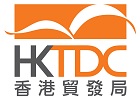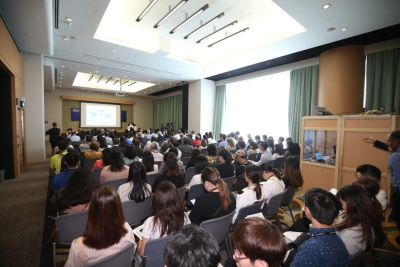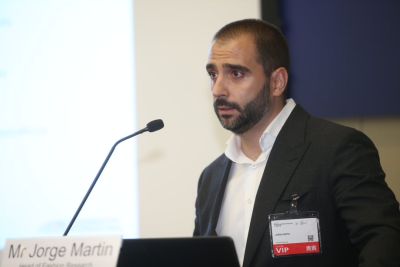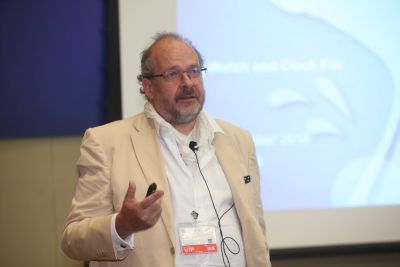|
| Friday, 7 September 2018, 17:00 HKT/SGT | |
| |  | |
Source: HKTDC | |
|
|
|
|
| Global Market and Road to Pioneering Inventions Examined |
HONG KONG, Sept 7, 2018 - (ACN Newswire) - Are smart watches cannibalising sales of traditional timepieces? The answer is no, although the next generation of innovation will focus on smart watches, according to speakers at this year's Asian Watch Conference, themed "Digital Revolution Reshapes Watch Manufacturing", held during the 37th HKTDC Hong Kong Watch & Clock Fair at the Hong Kong Convention and Exhibition Centre.
 | | Asian Watch Conference |
 | | Jorge Martin, Head of Fashion Research at Euromonitor International, presents an overview of the global watch industry at the Asian Watch Conference, held during the 37th HKTDC Hong Kong Watch & Clock Fair. |
 | | At the same conference, renowned Swiss watchmaking expert Elmar Mock shares his insights on how to turn ideas into reality. |
At the conference, Jorge Martin, Head of Fashion Research at Euromonitor International (EI), presented an overview of the global watch industry for 2018, while renowned Swiss watchmaking expert Elmar Mock shared his insights on how to turn ideas into reality.
Industry Overview
The US$68 billion watch industry has seen many new developments in the past three to four years, explained Mr Martin. These include economic problems in western Europe, a slowdown on the Chinese mainland and in Hong Kong, and massive growth in sales of smart watches, which has led to questions about their effect on sales of traditional watches.
Nevertheless, Mr Martin noted the industry is experiencing a recovery from the slowdown in 2015-16. EI projects 4% global growth in watch sales for this year and a 2% compound annual growth rate (CAGR) from 2018 to 2023.
There were no major changes in watch-company rankings from 2012 to 2017. The top three remained Rolex, Omega and Cartier, followed by Casio, Seiko, Citizen, Fossil, Swatch, Tag Heuer and Tissot, according to EI.
Distribution: Where are Consumers Buying Watches?
The vast majority of sales continue to come from independent physical retailers, observed Mr Martin. Sales by digital retailers are growing - at a consistent rate across regions - but they are still a small proportion of overall sales in all regions, although North America is the clear winner, Mr Martin said. Players such as Omega have decided to launch their own e-commerce platforms in the United States, he noted.
Smart Watches: Are they Cannibalising Traditional Watches?
Mr Martin explained that there has been a wide variety of responses from watch manufacturers to the introduction of smart watches. Fossil has invested heavily in repositioning its products towards smart pieces while traditional Swiss watch companies are now introducing at least one or two smart watches, after considering them to be just a phase a few years ago.
Offering a different perspective on smart watches, Mr Martin pointed out that all new consumer electronics go through a two-to-four-year period of double-digit expansion, followed by much weaker growth. This is also the case with smart watches, he said, which saw huge growth over the first few years and are still faring rather well but the growth rate has slowed considerably. Traditional watches, in contrast, which saw declining sales in 2015-2016, are now showing a healthy recovery, indicating the traditional-to-smartwatch transfer that many people blamed for declining sales of traditional watches was misplaced. EI research indicates that it is more about different consumers. "Many smart watch owners, for example, never wore a watch before," explained Mr Martin. "If there was some sort of transfer or shift from traditional to smart watches, we should see some sort of correlation in terms of total number of units lost and gained but the data shows no such correlation. Most of the sales of smart watches are for people who want to expand the functionality of their mobile phone, not to replace their watch."
Mr Martin said many people in the industry believe smart watches may even create a new market for traditional watches, as a new generation of consumers who have never worn a watch before become accustomed to it and switch to traditional watches. Therefore, EI predicts smart watches will still be a tiny percentage of overall watch sales even in 2023.
EI believes that if there is a shift from traditional to smart watches in specific markets, it is likely to be in the mid-price range (US$150-$1,000). Smart watches in this range by Fossil, for example, are performing best, as they offer essential functions - such as messages and phone call alerts - which people may not want to check on their mobile phone. So EI believes the relationship between traditional watches and smartphones is more likely to be co-habitation than competition because of the clearly different positioning. One example Mr Martin gave of positioning is Apple's focus on health and fitness, while traditional watch manufacturers focus on fashion for their smart watches.
EI forecasts a 3% CAGR for traditional watches over the next five years compared to 6% growth for smart watches, versus an expected growth of 18% for smart watches in 2018. One reason for the present and projected slowdown in the growth of smart watches is that all of them offer basically the same functionality, so consumers need only one. Another factor, according to EI consumer surveys, is growing concern among consumers about how much time they spend online and how much information they share online.
But there are opportunities as well, said Mr Martin. One is health, particularly senior health, and another is the convenient payment method smart watches provide.
"My opinion, based on the numbers, is that there is no such thing as cannibalisation in most cases between smart pieces and traditional watches," concluded Mr Martin.
The Creative Process: Making the Impossible Possible
The market cannot give answers for the future and someone has to dream for the market - this was Elmar Mock's advice to participants at the Asian Watch Conference in a talk titled "Revolution or Evolution". Mr Mock is a professional inventor and entrepreneur with 40 years of international experience.
Mr Mock used intriguing metaphors to illustrate the different mental states and stages involved in creating, developing and bringing a product to market. His experience in the watch industry started with Swatch in the late 1970s, when in response to the devastating effect of digital watches made in Japan and Taiwan on the Swiss watch manufacturing industry, he convinced his boss to produce a low-cost watch using a plastic strap, less than half the usual number of parts and a welded body that couldn't be repaired. The idea was to produce a watch for US$10. His colleagues were horrified at the idea, he said. His dream was to sell five million watches eventually. In the end, they produced a watch for US$5 instead of US$10, and Swatch has sold 600 million watches instead of five million, generating cash flow of more than US$8 billion.
The job of innovators, said Mr Mock, was to transform, to do the impossible, and not to wait for the market to tell them what to do. He explained that designing and manufacturing a low-cost watch was only part of the journey to success. The next stage was deciding how to sell it. His team tried to convince low-cost pen supplier Bic as well as some battery manufacturers to sell it, but without success. In the end, they had to market the product under their own brand. A consultant suggested they market the watch as a fashion item, and that opened the door to a new way of thinking. When they approached United States retailer Bloomingdales, they suggested placing the watches in the fashion department of stores rather than in the watch section, and the concept took off from there. The slogan: Swatch - Fashion that ticks.
"Every successful product has a point of view," maintained Mr Mock, "which must include (1) technical feasibility, (2) business viability, and (3) customer desirability."
"Humans are deeply involved in creation and innovation," he noted, advising watchmakers to ask themselves how they can influence innovation. "Why must we always be the same?" he asked.
Three Stages to Innovation
In describing the innovative process, he used the analogy of gas, liquid and solid states to describe mental states. He called the gas stage the exploration stage. This is the creative stage, which is about freedom, inspiration, dreams, illusions, inventions, imagination, chaos and utopia. This is where ideas start, but people with this mindset cannot usually take a product to market. The next stage is the liquid phase, or the research and development (R&D) stage, which involves coordination and evolution, as well as blood, sweat and tears. This is the stage where the dream becomes reality. The third stage is the solid stage, during which the product is prepared for manufacturing and the market. It is defined by logic, efficiency, structure, systems, reality, stability and maturity. Mr Mock said that while the three types of people needed for these stages do not necessarily understand each other, they need each other for a product to succeed.
Mr Mock also called for innovation. "You have to innovate and dream to survive," he said. "Look at what is impossible. Embrace hurdles, because they block your competitors. You have to be willing to make mistakes to envision something new."
On the topic of smart watches, Mr Mok noted that the smart phone is a hybrid of a phone, watch and camera, just as the smart watch is a hybrid of a smartphone and traditional watch. He predicted that hybrids will be the next generation of innovation.
Mr Mock argued that most companies in the watch industry are living in the past and that to survive they must actively shape the future. "Make the impossible possible - that is the message," he concluded.
Fair Websites
HKTDC Hong Kong Watch & Clock Fair: www.hktdc.com/fair/hkwatchfair-en
Salon de TE: http://event.hktdc.com/fair/te-en/TE/
- 4-8 Sept: Trade visitors aged 18 or above only (Free admission)
- 8 Sept: Salon de TE opens to public visitors age 12 or above (Free admission)
Photo download: https://bit.ly/2MXlA9O
Contact:
HKTDC's Communication and Public Affairs Department
Sunny Ng, Tel: +852 2584 4357, Email: sunny.sl.ng@hktdc.org
Joshua Cheng, Tel: +852 2584 4395, Email: joshua.cp.cheng@hktdc.org
Topic: Trade Show or Conference
Source: HKTDC
Sectors: Watches & Jewelry
https://www.acnnewswire.com
From the Asia Corporate News Network
Copyright © 2025 ACN Newswire. All rights reserved. A division of Asia Corporate News Network.
|
|
|
|

|
|
|
|